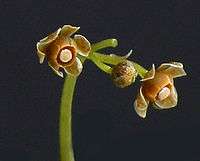Stephania
| Stephania | |
|---|---|
_001.jpg) | |
| Scientific classification | |
| Kingdom: | Plantae |
| (unranked): | Angiosperms |
| (unranked): | Eudicots |
| Order: | Ranunculales |
| Family: | Menispermaceae |
| Genus: | Stephania Lour. |
| Species | |
|
See text | |
Stephania is a genus of flowering plants in the family Menispermaceae, native to eastern and southern Asia and Australasia. They are herbaceous perennial vines growing to around four metres tall, with a large, woody caudex. The leaves are arranged spirally on the stem, and are peltate, with the leaf petiole attached near the centre of the leaf. The name Stephania comes from the Greek, "a crown". This refers to the anthers being arranged in a crown like manner.[1]
One species, S. tetrandra, is among the 50 fundamental herbs used in traditional Chinese medicine, where it is called han fang ji (漢防己, "Chinese fang ji"). Other plants named fang ji are sometimes substituted for it. Other varieties substituted include Cocculus thunbergii, C. trulobus, Aristolochia fanchi, Stephania tetrandria, and Sinomenium acutun. Notable among these is guang fang ji (廣防己, "(GuangDong,GuangXi) fang ji", Aristolochia fanchi. Because of its toxicity, it is used in TCM only with great caution.
Toxicity

At least some, possibly all, species of Stephania, such as Stephania tetrandra, contain toxic amounts of aristolochic acid and can cause renal failure and even death. It should not be taken with NSAIDs due to possible kidney damage or failure.[2]
Chemistry
Chemical investigation of Stephania rotunda Lour. growing in Vietnam in 2005 led to the isolation and structural elucidation of three new alkaloids, 5-hydroxy-6,7-dimethoxy-3,4-dihydroisoquinolin-1(2H)-one, thaicanine 4-O-beta-D-glucoside, as well as (−)-thaicanine N-oxide (4-hydroxycorynoxidine), along with 23 known alkaloids.[3]
Selected species
There are about 45 species in the genus Stephania, native to the Far East and Australasia.[4] Species include:[5]
|
|
References
- ↑ Les Robinson. Field Guide to the Native Plants of Sydney. p. 336. ISBN 978-0-7318-1211-0.
- ↑ Nunez, Kelvin R. (2006). Trends in Kidney Cancer Research. 18. Hauppauge, New York: Nova Science Publishers. p. 78. ISBN 1-59454-141-8.
- ↑ Thuy, T. T; Porzel, A.; Franke, K.; Wessjohann, L.; Sung, T. V. (September 2005). "Isoquinolone and protoberberine alkaloids from Stephania rotunda". Die Pharmazie. 60 (9): 701–704. PMID 16222872.
- ↑ Forman, L. L. (1988). "A Synopsis of Thai Menispermaceae". Kew Bulletin. Royal Botanic Gardens, Kew. 43 (3): 369–407. doi:10.2307/4118970. JSTOR 4118970.
- ↑ GRIN. "GRIN Species Records of genus Stephania". Taxonomy for Plants. National Germplasm Resources Laboratory, Beltsville, Maryland: USDA, ARS, National Genetic Resources Program. Retrieved September 29, 2013.
External links
| Wikimedia Commons has media related to Stephania. |
- "Stephania Lour.". Australian Plant Name Index (APNI), IBIS database. Centre for Plant Biodiversity Research, Australian Government.
- Flora of China: Stephania species list
- Flora of Nepal: Stephania species list